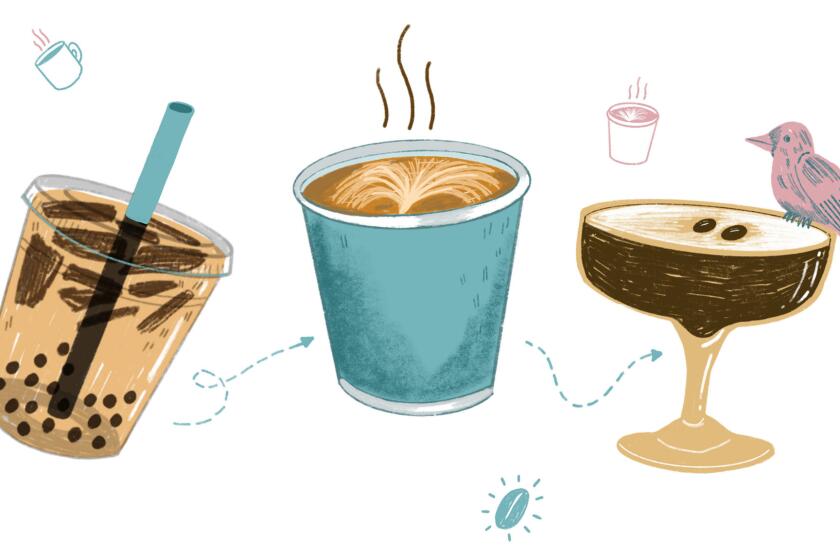Go Get Em Tiger, L.A.’s burgeoning coffee franchise, is serving up one of the city’s best cheeseburgers
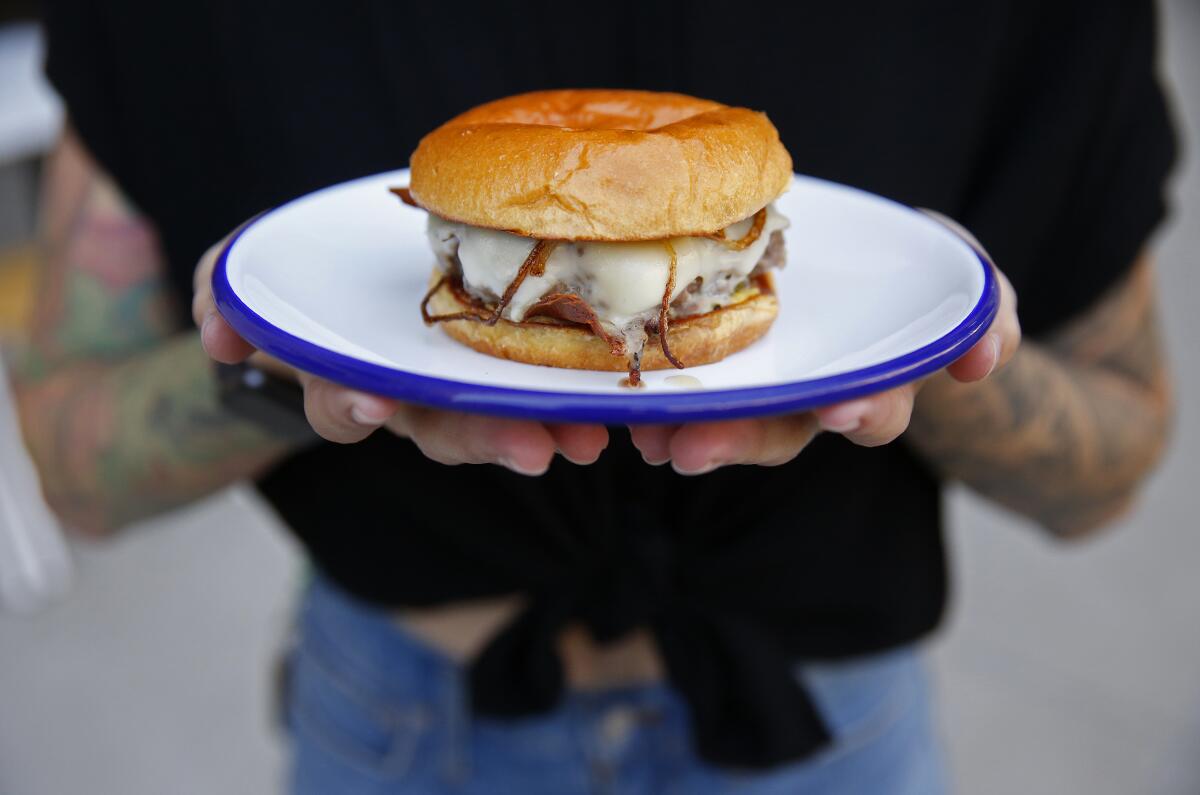
- Share via
Sometimes a burger is not just a burger.
Here at the Row DTLA, a sprawling complex of upscale dining, boutique lifestyle shopping and still mostly empty commercial offices, one of the best new cheeseburgers in Los Angeles is served at Go Get Em Tiger.
For the record:
11:19 a.m. Oct. 24, 2019Intelligentsia’s Sunset Boulevard cafe opened in 2007, not 2008 as previously stated.
This is the company’s sixth location but the first to serve this exercise in burger minimalism: 5 ounces of smashed beef, caper aioli, Cooper’s American cheese imported from upstate New York, griddled onions and pickles. It arrives wanting for nothing except, perhaps, some kind of explanation: How is a burger this good being served at a coffee shop?
“The burger is the kind of thing that we knew was going to change our story a little bit,” co-founder and Chief Executive Kyle Glanville says.
That story is one of bootstrap start-up and riotous growth, with seven cafes to date and a proposed 30 more to come across Southern California in the next few years, as well as a new 16,000-square-foot operations headquarters in Vernon.
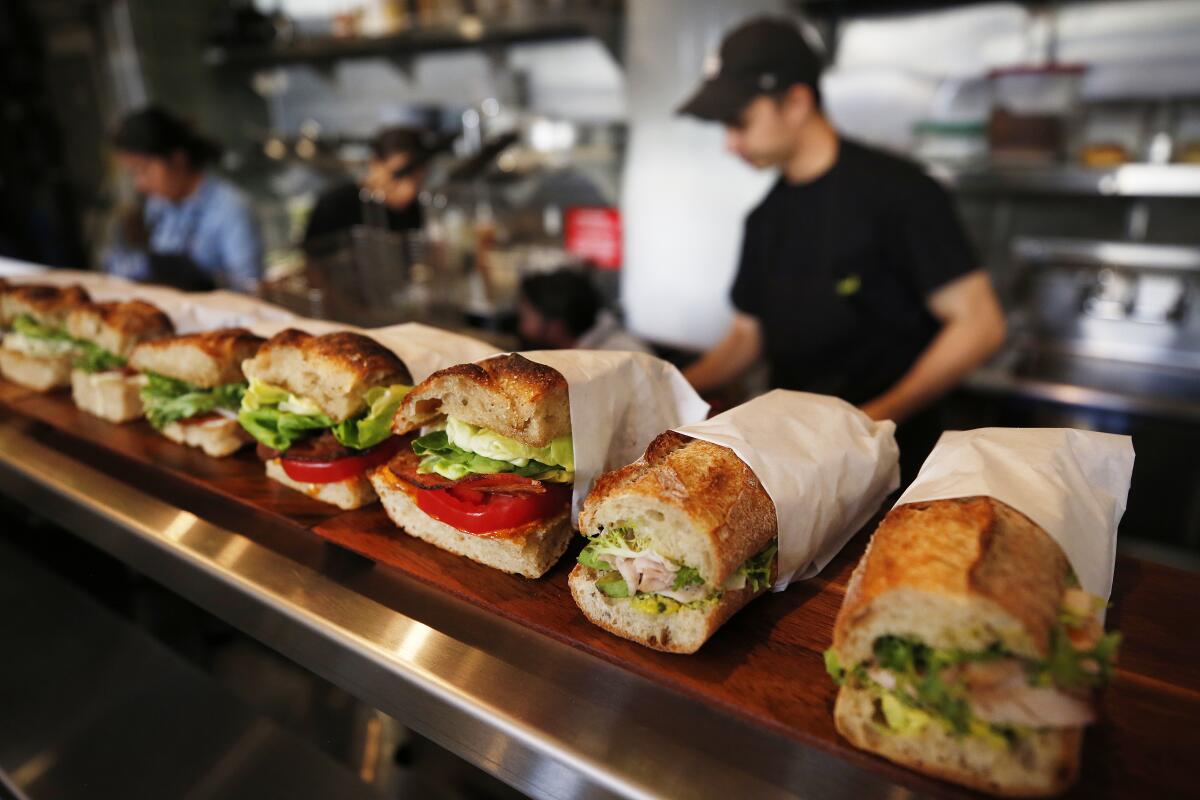
Great coffee is, of course, at the core, with accessible flavor profiles focused on easy-to-drink washed coffees from Honduras, Ethiopia, Colombia and Kenya. But Go Get Em Tiger is aiming to be more than just a coffee shop; restaurant-caliber food and cool apparel fit for a boutique clothing shop are part of the brand’s growing identity as a coffee lifestyle company.
The company has grown through a unique fundraising and investment model that relies not on any one single firm or partner but instead on dozens of small-scale individual investors, each buying in to the company at an average of $50,000.
I’ve been following Go Get Em Tiger for the better part of a decade through my work at Sprudge, the coffee publication that I co-founded. We’ve watched as coffee culture in Los Angeles has undergone a massive boom and become an inflection point for major national coffee brands like Intelligentsia, Verve, la Colombe, Stumptown and Blue Bottle. For these brands, the move to L.A. is part of an expansion narrative; for Go Get Em Tiger (stylized as GGET), it is a local story.
The company launched as G&B Coffee in 2012 as a humble owner-operated cafe pop-up inside Sqirl. Glanville took coffee orders and greeted customers; co-founder Charles Babinski (the “B” to Glanville’s “G”) made meticulous coffee drinks from a range of specialty coffee roasters from across North America.
The duo — Glanville is 36, Babinski, 34 — are well-known in modern coffee culture for their previous work with Intelligentsia (Glanville helped open the brand’s landmark Sunset Boulevard cafe in 2007). Both are United States Barista Champions, having won an annual tournament for competitive coffee-making that’s something like a caffeinated version of “Top Chef.”
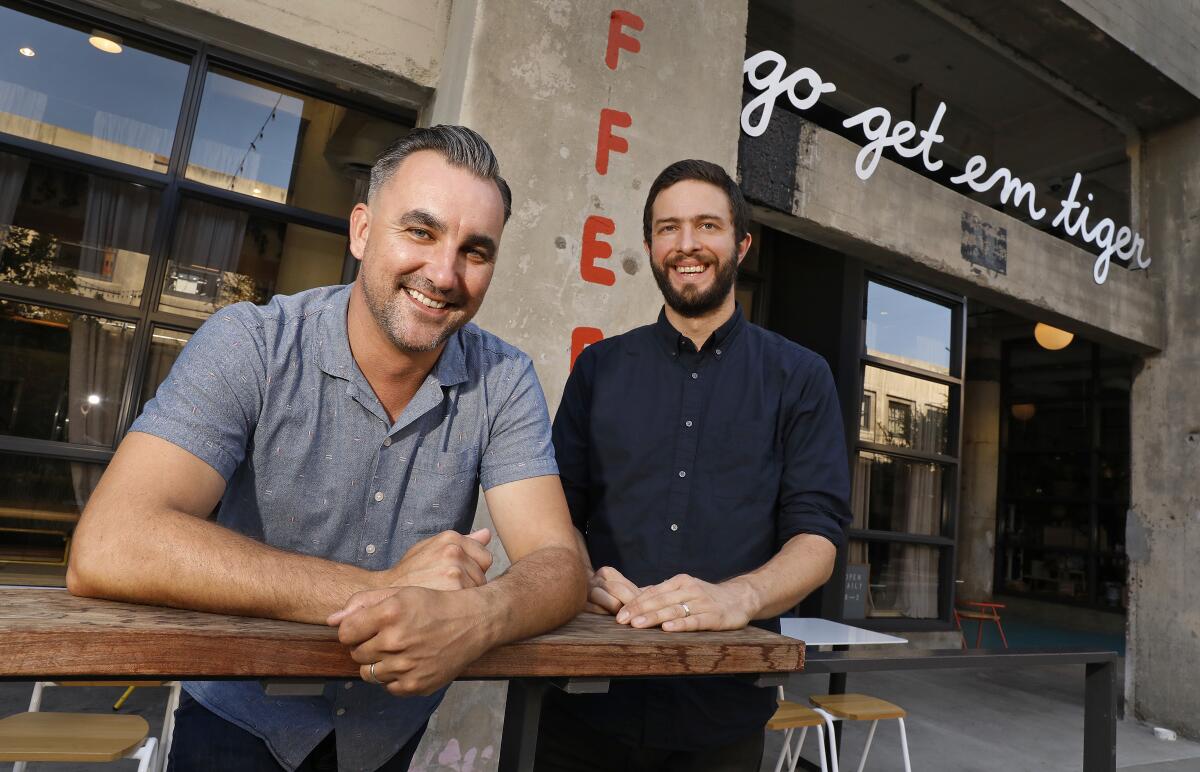
The pop-up at Sqirl was short-lived, followed by a move to Grand Central Market, where since 2013 the brand has occupied an open-air coffee bar at the market’s Hill Street entrance. That was followed by the first cafe under the Go Get Em Tiger name, opened in a bright and airy space in Larchmont Village later in 2013. A second Go Get Em Tiger opened in 2016 in Los Feliz, followed quickly by a raft of openings in Highland Park, the Arts District, the aforementioned space at the Row and most recently at the Music Center, where GGET’s cafe is part of a newly remodeled campus for Center Theatre Group, L.A. Opera and the L.A. Philharmonic.
An eighth GGET cafe is coming, occupying a disused box office space at the ArcLight Cinemas Cinerama Dome in Hollywood.
“Places like the Music Center, Grand Central and now ArcLight, these are L.A. institutions,” Glanville says. “Being part of that is important for us.”
Chinatown today is a neighborhood in flux, a place of cultural collision with new energy, new entrepreneurs, and cultures from around the world.
Along the way GGET has come to occupy multiple identities: a point of pilgrimage for coffee culturalists from around the world but also a neighborhood cafe chain; a native Angeleno business that happens to be owned and operated by transplants (Babinski is from Colorado, Glanville from Carmel Valley).
It’s a coffee bar chain that roasts its own coffee and serves excellent food, and a model for hip coffee culture with its own clothing line and iconography. Glanville and Babinski have translated hunches into practices, which then become trends industrywide. When Go Get Em Tiger began pregrinding its espresso doses and serving filter coffee from a large-batch brewer, it was looked at by the specialty coffee industry — then obsessed with fussy pour-overs — as an act of heresy. Today it is de rigueur in coffee bars in markets large and small around the country, with many directly inspired by GGET.

Like most successful business partners, Babinski and Glanville have built their growing empire through a smart division of labor, rooted in the duo’s individual personalities. Babinski is the chief product officer and chief technical officer — in coffee, the product is the tech — allowing him a daily deep dive into product quality obsessiveness.
Glanville is chief executive, a role that includes investor meetings and Whole Foods product demos.
“My focus is more outward,” he explains. “That means expansion, new locations and brand stuff, whereas Charles’ role is more inward, building the coffee team and focusing on product.”
This includes the company’s recent transition from “multiroaster” — a coffee-nerd term for a cafe that serves coffees from multiple roasters — to roasting its beans in-house. “From a personal aesthetic, my taste is always changing,” Babinski says. “Our approach to coffee has a lot of room to grow.”
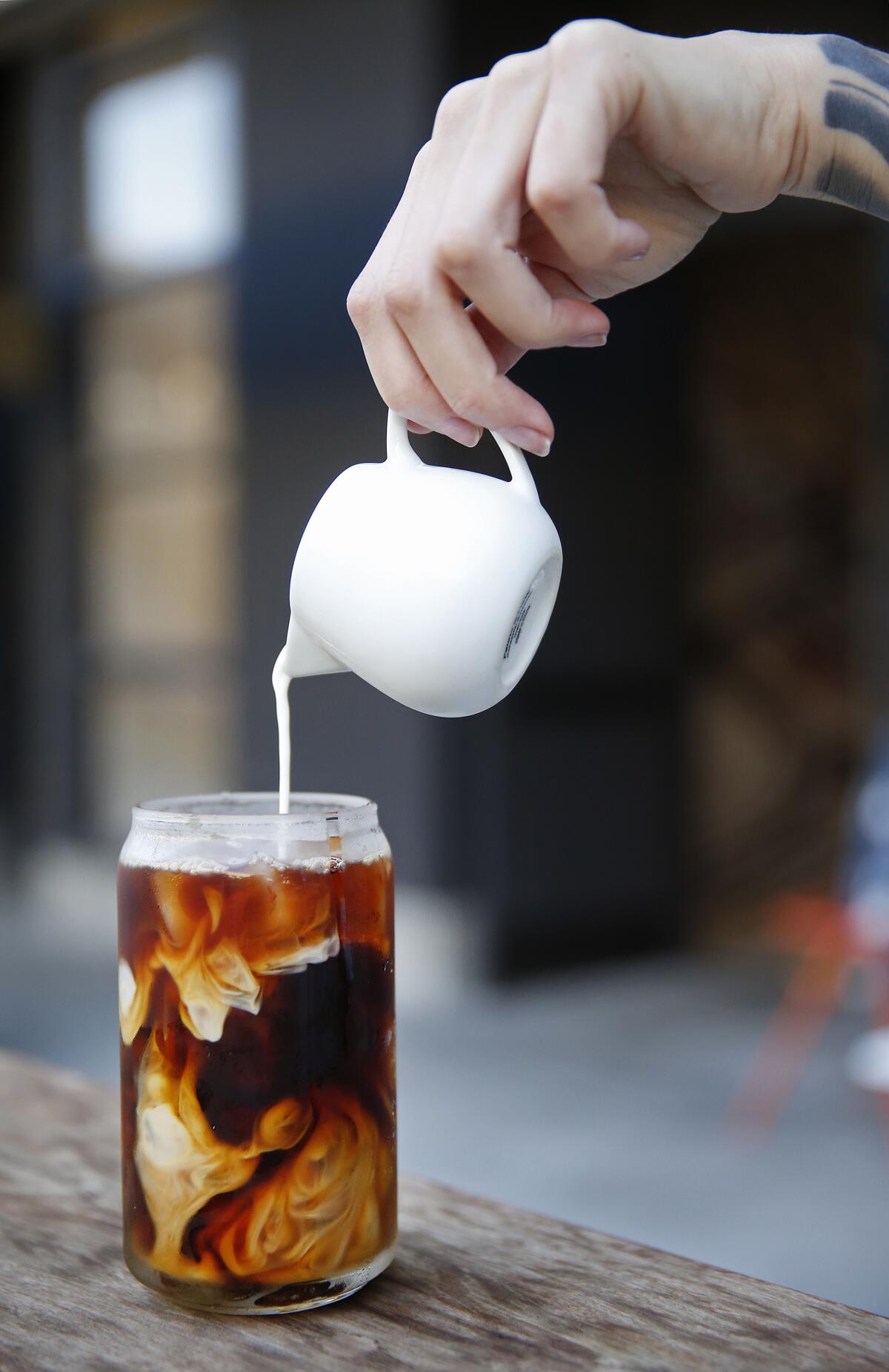
In addition to a growing staff of 120, including culinary and coffee quality teams spread between roasting and R&D facilities in Vernon and a commissary kitchen in Westlake, G&B has found a group of partners from among L.A.’s food and beverage investor set.
Chief among them is Yoram Heller, 35, the lead investor for Go Get Em Tiger, who occupies the third seat on the company’s three-person board. Other investors include comedy writer and TV producer Dan Goor, music executive and art collector Matthew Aberle, musician Jesse Kivel and Spotify executive Jeremy Erlich.
Like nearly every member of GGET’s initial investment group, Heller knew Babinski and Glanville first as a cafe regular.
“I just developed a real affinity for what they were doing,” says Heller, whose investment portfolio includes bespoke cannabis brand Sunday Goods, of which he’s co-CEO/cofounder and the salad chain Sweetgreen.
When Trish Rothgeb coined the term “third-wave coffee” in 2002, she didn’t know it would be used to define an entire era in the coffee industry.
Heller helped Babinski and Glanville formalize the duo’s first three cafes into a corporate entity, preparing them for rapid expansion in coming years (the company declined to provide revenue or profit figures). With a healthy dose of investor optimism, Heller sees a host of parallels between GGET and Sweetgreen, now valued at $1.9 billion.
Coffee culture in Los Angeles — indeed, across America — shows no sign of slowing, with new cafes opening seemingly every day, populating every last pocket from the city to the Valley and beyond. As a trend it appears to be both Amazon- and Walmart-proof, at least for now.
“There is still a ton of opportunity in the coffee space,” Heller says. “Whether that’s secondary cities — places like Nashville or Houston that don’t have dominant coffee businesses — or somewhere like San Diego or Orange County, I see a lot of growth and possibilities.” Even in New York, “I don’t see anyone dominating.”

Back to the burger. It’s not just a burger; it is symbolic of GGET’s entire approach to R&D, cafe presentation, mise en place and execution. Go Get Em serves the best cheeseburger I’ve ever had in a coffee shop, which sounds like it could almost be a put-down until you think about the future of coffee shops.
“The burger is no different from a cappuccino,” Glanville says. “We know the recipe. If you try and do wacky [stuff] with burgers or cappuccinos, well ... what I like about this business is getting all the details right, making something that adds up to an experience that’s recognizably the same as what’s already out there, but better.”
The meat is smashed and grilled just so. The bun has the correct amount of fluff. The cheese fuses flavoristically with the pickle and onion, yet each retains its own distinct texture of contrasting snap-and-give. Just a little bit of the caper aioli catches at the side of your mouth.
The burger becomes emblematic of a wider experience, suggesting more for what the modern coffee shop can be. You can downright taste it.
More to Read
Eat your way across L.A.
Get our weekly Tasting Notes newsletter for reviews, news and more.
You may occasionally receive promotional content from the Los Angeles Times.

